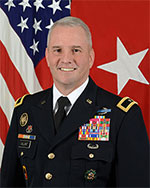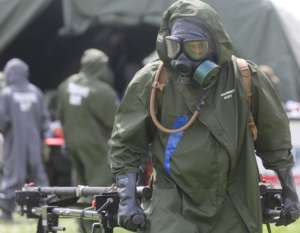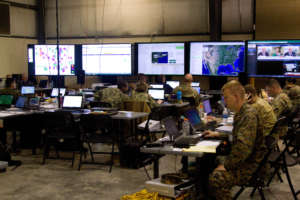
Whole of nation response to nuclear attack tested in Vibrant Response 17
The Defense Department’s Joint Task Force Civil Support (JTF-CS) participated in Vibrant Response 17 over the last month in an effort to better prepare for a...
If a massive nuclear, biological or other type of incident happened in the U.S., the rule of thumb is federal first responders don’t want to be trading business cards with their state and local partners as they respond.
The latest interagency, inter-governmental exercise, called Vibrant Response 17, aims to do more than introduce first responders.

Photo courtesy Joint Task Force-Civil Support.
Michael Collins, the Joint Task Force Civil Support (JTF-CS) deputy to the commander, said this annual event is about preparing for a whole of nation response to an epic attack or accident.
He said the exercise brings together the Defense Department, the Homeland Security Department, the Federal Emergency Management Agency (FEMA), the Transportation Department, the U.S. Army Corps of Engineers, and a host of state and local law enforcement and emergency agencies to test and improve tactics, techniques and procedures (TTPs).
“The reason our organization exists is, and God-forbid anything should happen, if there was a chemical, biological, radiological or nuclear event in the U.S. — and the reason I say event and not attack is because it could be a something like a nuclear power plant meltdown that they experienced in Fukushima, Japan, or it could be a weapon of mass destruction. But if we ever had a chemical, biological, radiological or nuclear event in the U.S., Joint Task Force Civil Support and our subordinate forces would be there to assist the lead federal agency, usually FEMA, in responding to the incident,” Collins said in an exclusive interview with Federal News Radio.
Collins said the annual certification exercise also helps make sure his organization can conduct urban search-and-rescue and other life-saving operations.
Vibrant Response 17 was one of several exercises that happened toward the end of April and into May to ensure federal, state and local emergency responders know their roles and responsibilities.
The exercise centered around a fictitious 10-kiloton nuclear device exploded in the Lincoln Tunnel in New York City.
JTF-CS sent teams to Albany, New York, and to Trenton, New Jersey, to help coordinate some of the federal response for the states, and integrate the DoD portion of the response to the emergency, said Stan Bacon, the Joint Task Force Civil Support deputy for plans, policy and interagency coordination.
“It was a great opportunity for the whole of community, the whole of government to help solve a common problem,” Bacon said. “It gave a chance for the different agencies to talk to each other, find out creative ways to help them overcome the effects of [the improvised nuclear device] on the population.”
Collins said this year the exercise included hundreds of role players who used make-up and other devices to simulate the aftermath of the incident. The soldiers, airmen and Marines responded to the exercise at multiple locations around the country.
“They were able to practice all these skill sets including triage, medical stabilization, decontamination of personnel, both ambulatory and non-ambulatory personnel, and then medically evacuating them either by air ambulance or Army field ambulances,” Collins said.
Additionally, JTF-CS worked directly with the directors of the emergency operations centers from New Jersey and New York.
Collins said previously the exercise could only bring in former or retired EOC directors. So by having the people in the positions today, the training becomes more valuable.
The reason why these exercises are so important is when an incident occurs, it starts out as a states’ rights issue, and the federal government, particularly DoD, must be invited in to help.

Service members take part in Vibrant Response 17 by ensuring communication links stay connected.
Photo courtesy Joint Task Force-Civil Support.
Collins said when the state and local government can no longer handle the magnitude of the incident, the federal response becomes critical.
“What makes this exercise so important is it doesn’t just happen. It takes incredible coordination for the city, the state, the federal government and the DoD to respond to whatever it is the incident commander needs, in the quantities they need and where and when they need it in responding to the incident,” he said. “So practicing is a golden opportunity.”
Bacon said after the actual exercise is completed in the next week or so, JTF-CS and its partners will review the TTPs and improve them as necessary.
“I think overall the concept, at least from the federal side of the house, was pretty well laid down. I think we will need to much more quickly integrate some of our capabilities into the response,” he said. “As a whole, the community, especially at the federal level, we need to find ways to help the states overcome the resource restrictions they have for exercises. For example, New York and New Jersey weren’t able to participate for every day of the exercise. It wasn’t for a lack of desire or will, but people’s time equates to money and if they are at an exercise and there is real stuff going on in the state somebody else has to do it. So in a way, you are paying two paychecks. I think it behooves the federal government to find a way to help them. The more they get involved, the better our plans will be at execution.”
Collins added in a perfect world, DoD could run these exercises annually in every state. He said since every state operates a little differently, it would help DoD and the federal government writ large to understand all the different pieces and parts to responding to emergency situations.
Copyright © 2025 Federal News Network. All rights reserved. This website is not intended for users located within the European Economic Area.
Jason Miller is executive editor of Federal News Network and directs news coverage on the people, policy and programs of the federal government.
Follow @jmillerWFED



